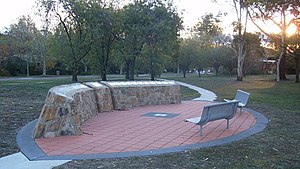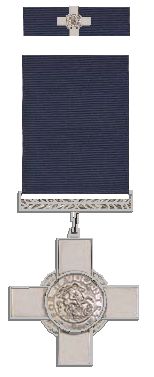
The Distinguished Flying Cross (DFC) is the third-level military decoration awarded to officers, and since 1993 to other ranks, of the United Kingdom's Royal Air Force and other services, and formerly to officers of other Commonwealth countries, for "an act or acts of valour, courage or devotion to duty whilst flying in active operations against the enemy".

The Most Excellent Order of the British Empire is a British order of chivalry, rewarding contributions to the arts and sciences, work with charitable and welfare organizations, and public service outside the civil service. It was established on 4 June 1917 by King George V and comprises five classes across both civil and military divisions, the most senior two of which make the recipient either a knight if male or dame if female. There is also the related British Empire Medal, whose recipients are affiliated with, but not members of, the order.
The George Cross (GC) is the highest award bestowed by the British government for non-operational gallantry or gallantry not in the presence of an enemy. In the British honours system, the George Cross, since its introduction in 1940, has been equal in stature to the Victoria Cross, the highest military award for valour. It is awarded "for acts of the greatest heroism or for most conspicuous courage in circumstance of extreme danger", not in the presence of the enemy, to members of the British armed forces and to British civilians. Posthumous awards have been allowed since it was instituted. It was previously awarded to residents of Commonwealth countries, most of which have since established their own honours systems and no longer recommend British honours. It may be awarded to a person of any military rank in any service and to civilians including police, emergency services and merchant seamen. Many of the awards have been personally presented by the British monarch to recipients or, in the case of posthumous awards, to next of kin. The investitures are usually held at Buckingham Palace.

The Distinguished Service Order (DSO) is a military decoration of the United Kingdom, as well as formerly of other parts of the Commonwealth, awarded for operational gallantry for highly successful command and leadership during active operations, typically in actual combat. Since 1993 it has been awarded specifically for "highly successful command and leadership during active operations", with all ranks being eligible. It is a level 2A decoration (order) in the British system of military decorations.
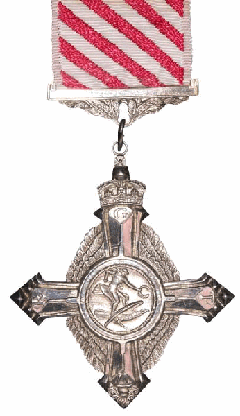
The Air Force Cross (AFC) is a military decoration awarded to officers, and since 1993 other ranks, of the British Armed Forces, and formerly also to officers of the other Commonwealth countries. It is granted for "an act or acts of exemplary gallantry while flying, though not in active operations against the enemy". A bar is added to the ribbon for holders who are awarded a further AFC.

The Air Force Medal (AFM) was a military decoration, awarded to personnel of the Royal Air Force and other British Armed Forces, and formerly to personnel of other Commonwealth countries, below commissioned rank, for "an act or acts of valour, courage or devotion to duty whilst flying, though not in active operations against the enemy". The award was discontinued in 1993 when all ranks became eligible for the Air Force Cross (AFC) as part of the reform of the British honours system.

The British Empire Medal is a British and Commonwealth award for meritorious civil or military service worthy of recognition by the Crown. The current honour was created in 1922 to replace the original medal, which had been established in 1917 as part of the Order of the British Empire.
The Edward Medal was a British civilian decoration which was instituted by royal warrant on 13 July 1907 to recognise acts of bravery of miners and quarrymen in endangering their lives to rescue their fellow workers. The medal was named in honour of King Edward VII. The original royal warrant was amended by a further royal warrant on 1 December 1909 to encompass acts of bravery by all industrial workers in factory accidents and disasters, creating two versions of the Edward Medal: Mines and Industry.
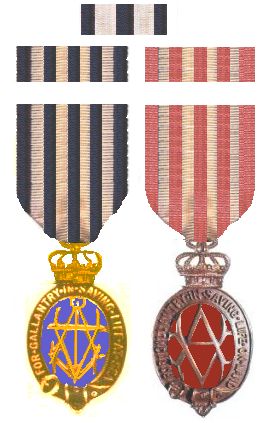
TheAlbert Medal was a British decoration instituted to recognize the saving or endeavouring to save the lives of others. It existed from 1866 until 1971.

The Medal of the Most Excellent Order of the British Empire for Gallantry, known as the Empire Gallantry Medal (EGM), was a British medal awarded for acts of gallantry. Unlike the then existing Sea Gallantry Medal (SGM) (1854), the Albert Medal (AM) (1866) and the Edward Medal (EM) (1907) which each had two classes with restricted eligibility criteria, the EGM was a single class award with wide eligibility. It was instituted by King George V on 29 December 1922. In July 1937, recipients were granted the right to use the post-nominal letters "EGM". The EGM was superseded in 1940 by the George Cross which was also a single class award with wide eligibility but unlike the low placed EGM on the Order of Wear, the George Cross was listed immediately after the Victoria Cross.
The Victoria Cross for Australia is the highest award in the Australian honours system, superseding the British Victoria Cross for issue to Australians. The Victoria Cross for Australia is the "decoration for according recognition to persons who in the presence of the enemy, perform acts of the most conspicuous gallantry, or daring or pre-eminent acts of valour or self-sacrifice or display extreme devotion to duty".

The Victoria Cross (VC) is the highest and most prestigious decoration of the British honours system. It is awarded for valour "in the presence of the enemy" to members of the British Armed Forces and may be awarded posthumously. It was previously awarded to service personnel in the broader British Empire, with most successor independent nations now having established their own honours systems and no longer recommending British honours. It may be awarded to a person of any military rank in any service and to civilians under military command. No civilian has received the award since 1879. Since the first awards were presented by Queen Victoria in 1857, two thirds of all awards have been personally presented by the British monarch. The investitures are usually held at Buckingham Palace.
Arthur Gerald Bagot, was an Australian naval officer and farmer. He was an exchange recipient of the George Cross, the highest civil decoration for heroism in the United Kingdom and formerly in the Commonwealth. In 1918, while serving as a lieutenant in the Royal Naval Volunteer Reserve during the First World War, Bagot and Lieutenant Robin Hoare battled flames to remove depth charges from ML 356 after its engine room had exploded. The pair were credited with preventing a further explosion and thus potential casualties, and were subsequently awarded the Albert Medal. In 1971, the British Government announced that the Albert Medal would be discontinued and living recipients would henceforth be regarded as holders of the George Cross. The change came into effect from 21 October, and living recipients were accordingly invited to exchange their medals; Bagot took up the offer.
John Chalmers, GC was a New Zealand-born Australian exchange recipient of the George Cross, the highest decoration for gallantry awarded to civilians or to military personnel for actions "not in the face of the enemy" in the United Kingdom and Commonwealth. A member of the North Bondi Surf Life Saving Club, Chalmers was awarded the Albert Medal in 1922 for his actions in rescuing a swimmer during a shark attack at Coogee Beach. With the establishment of the George Cross, the Albert Medal was discontinued and, in 1971, living recipients of the decoration were invited to exchange their medal for the George Cross; Chalmers took up the offer and formally became a recipient of the George Cross.

William Simpson McAloney, was a senior engineering officer in the Royal Australian Air Force (RAAF) and an Australian exchange recipient of the George Cross, the highest civil decoration for heroism in the United Kingdom and formerly in the Commonwealth. Born in Adelaide, he worked as a mechanic before enlisting in the RAAF as an aircraft engine fitter in 1936. In August the following year, he attempted to rescue the pilot of a crashed Hawker Demon aircraft engulfed in flames at an airfield in Hamilton, Victoria. The first on scene, McAloney rushed into the wreckage in an effort to extract the unconscious pilot. The pilot's leg was trapped, however, and while struggling to free it one of the wing tanks burst, knocking McAloney unconscious. McAloney was pulled from the aircraft suffering severe burns and spent the next month in hospital. He was subsequently awarded the Albert Medal for his actions in the rescue attempt.
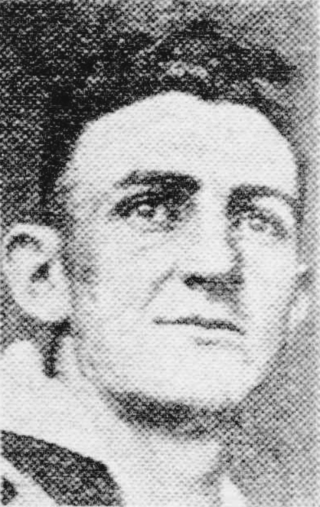
Robert Murray Kavanaugh GC was an Australian recipient of the Albert Medal, formerly the highest decoration for gallantry awarded to civilians or to military personnel for actions "not in the face of the enemy" in the United Kingdom and Commonwealth. A dental student, Kavanaugh was awarded the Albert Medal following his rescue of a youth during a shark attack at Bondi Beach in January 1929. With the establishment of the George Cross, the Albert Medal was discontinued and, in 1971, living recipients of the decoration were invited to exchange their medal for the George Cross; Kavanaugh took up the offer and formally became a recipient of the George Cross.

Stanley Frederick Gibbs, GC was an Australian shipping clerk and an exchange recipient of the George Cross, the highest civil decoration for heroism in the United Kingdom and formerly in the Commonwealth. On 3 January 1927, the day after his eighteenth birthday, Gibbs went to the rescue of 15-year-old Mervyn Allum during a shark attack at Port Hacking, New South Wales. He managed to fend off the shark by striking at it with his legs and fists and, with the assistance of a friend, pulled Allum clear of the water. Although Allum died from his injuries, Gibbs was publicly praised by the coroner and local community leaders for his actions, and was subsequently awarded the Albert Medal.
Gordon Love Bastian, was an engineering officer in the British Merchant Navy who was awarded the Albert Medal for risking his own life to save other members of the crew of SS Empire Bowman after it was torpedoed on 31 March 1943. In 1971, living recipients of the Albert Medal and Edward Medal were instructed to return their medal and were instead issued with the George Cross, the highest decoration for gallantry awarded to civilians or to military personnel for actions "not in the face of the enemy" in the United Kingdom and Commonwealth
